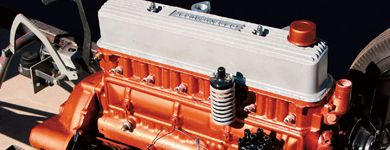
To those who know me (or for that matter ever even seen me), an article titled "Dress for Success" will be instantly recognized as oxymoronic, to say the least. Fortunately for all, I'll leave the clothing fashion sense to rags like GQ and stick with a subject that matters much more to me than matching socks-the appropriate care and dressing of a hot rod engine.
This particular engine is by no means representative of the average street rod powerplant, but in many cases the same methods can be used to prepare an already well-running donor engine for hot rod duty. My subject is a '60 Ford 223-cube inline-six I inherited from my friend and publisher Tim Foss. The engine was yanked out of his F-100 pickup to make room for a pretty stout 351, and seeing that it was a strong runner-and that I'm a sucker for oddball powerplants-Tim thought it'd make for a cool source of power for my "Homebuilt Hot Rod" project; as always, he was correct. So without hesitation, I loaded up the rather greasy 'n' grimy six-banger and dragged it home.
Though I'd previously seen the 223 power Tim's pickup through a hard day's thrashin' at the California Speedway (a whole story in itself by the way) and heard it purr without a stutter, there were a few things I wanted to check out before nestling it between the 'rails of my pickup. But it needed a serious bath before its "checkup," so I stocked up on some degreaser, grabbed a putty knife and a wire brush, and borrowed my pal's pressure washer for an afternoon of driveway hygiene.
Keeping in mind that what I do is not always 100-percent correct, there are a few important things I check when contemplating a used engine as the source of power for any project. The first thing I personally do is pull the dipstick and check out the oil to see if it's contaminated with water (if so, it usually looks more like a chocolate milkshake than crude), or if it's more like sludge than liquid. Satisfied that there's no water or massive amounts of sludge sliding off the dipstick, the next step is to pop off a valve cover to see what's found up top. If one finds an accumulation of tar-like sludge up there, it's a safe bet the engine hasn't received its fair share of care and/or maintenance and could end up being a bit too long in the tooth for use without a rebuild. If it looks pretty clean, my next step would be the aforementioned bath and a quick compression test. With the compression test completed and the result acceptable, I then proceeded to drop the pan. There are a couple things I normally replace on any used engine I contemplate using without rebuilding-the oil pump and timing chain set. That done, the only thing left is to put some lipstick on this pig-so check out the images of my "rattle-can" rebuild, and keep in mind that with a bit of attention and a wee bit o' luck, a used engine can end up being an inexpensive and reliable way to get a budget hot rod on the road.